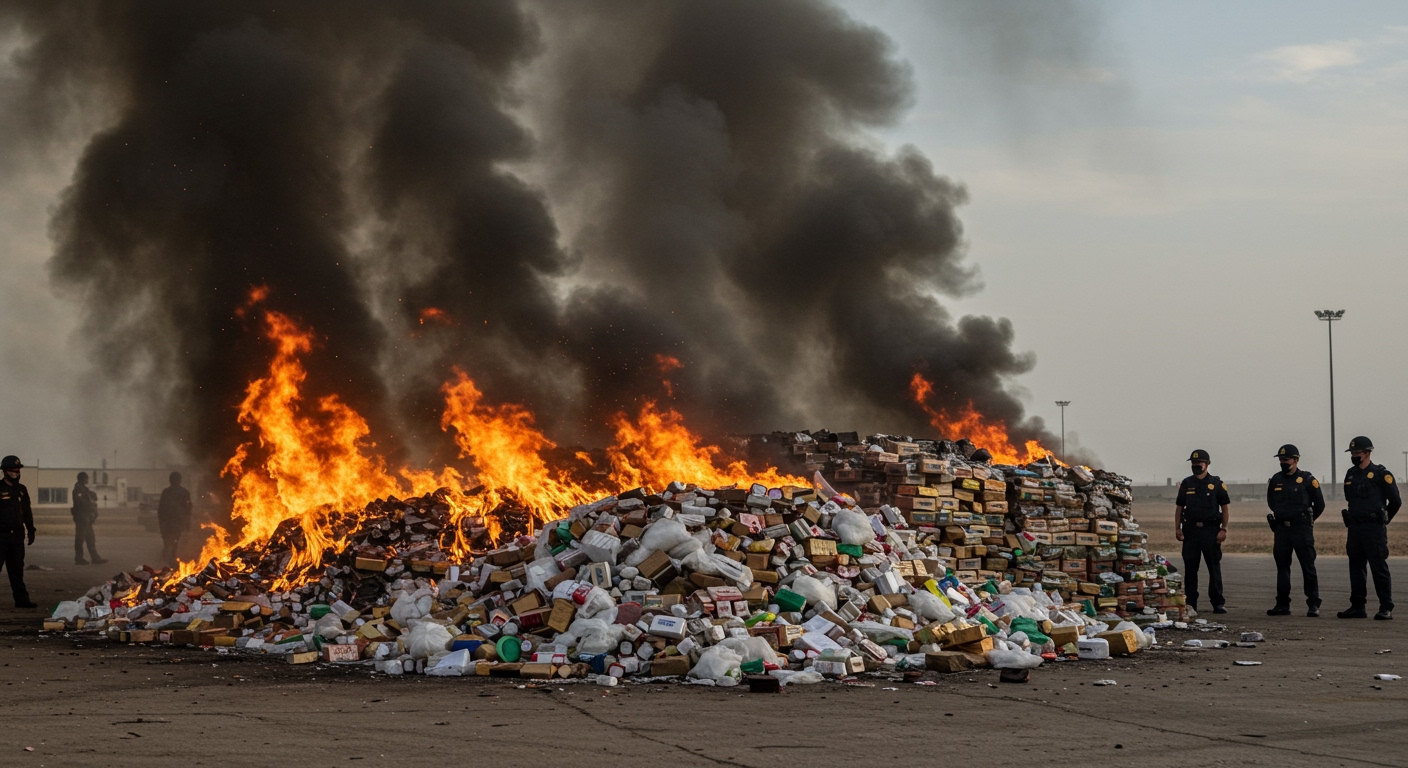YANGON, Myanmar – In a public display of anti-narcotics efforts, authorities in Myanmar incinerated approximately $300 million worth of confiscated illegal drugs on Thursday, June 26, 2025. The large-scale destruction ceremonies were conducted simultaneously in the nation’s major cities, including the commercial hub of Yangon, the cultural center of Mandalay, and Taunggyi in Shan State, a region often associated with illicit drug production.
Massive Drug Haul Incinerated Across Major Cities
The coordinated destruction aimed to underscore the government’s commitment to combating the pervasive drug trade, which continues to pose significant challenges domestically and regionally. Officials oversaw the burning of vast quantities of narcotics seized over the past year, encompassing a wide spectrum of illicit substances that fuel addiction and instability.
Details of the Destruction
The inventory of destroyed drugs included substantial amounts of opium, heroin, methamphetamine, marijuana, ketamine, and the highly potent stimulant known as ice or crystal meth. The sheer volume and variety of the narcotics highlighted the scale of the drug flow through the country.
Speaking at the ceremony in Yangon, Police Brig. Gen. Sein Lwin confirmed the significant value of the drugs destroyed in that location alone. “Today, we are destroying over $117 million worth of drugs here in Yangon,” he stated, emphasizing the impact of successful law enforcement operations.
A police official based in Naypyitaw, who requested anonymity due to the sensitivity of the matter, provided a precise valuation for the combined destruction across the three primary locations – Yangon, Mandalay, and Taunggyi. According to this official, the exact value of the drugs incinerated totaled $297.95 million.
Symbolic Timing and Global Efforts
The date chosen for the drug destruction, June 26, 2025, was highly symbolic, coinciding with the United Nations’ International Day Against Drug Abuse and Illicit Trafficking. This global observance serves to raise awareness of the major problems that illicit drugs represent to society and to mobilize support for drug control efforts. By scheduling the destruction on this day, Myanmar authorities aligned their action with international anti-narcotics campaigns.
Alarming Context: The Golden Triangle’s Resurgence
This public incineration takes place against a backdrop of escalating concerns from international bodies regarding the drug trade originating from Southeast Asia. It follows closely on the heels of a stark warning issued by U.N. experts nearly a month prior. That warning highlighted unprecedented levels of methamphetamine production and trafficking emanating from the notorious Golden Triangle region, an area historically known for illicit drug cultivation and production that encompasses parts of Myanmar, Thailand, and Laos.
Myanmar’s eastern Shan State, in particular, was identified in the U.N. warning as a primary source of this surging production, underscoring the deep-rooted nature of the problem within the country’s borders.
UNODC Report Highlights Crisis Link
The concerns articulated by the U.N. experts were substantiated by a detailed report released in May 2025 by the U.N. Office on Drugs and Crime (UNODC). The UNODC report provided a sobering assessment of the factors contributing to the dramatic increase in drug trafficking.
According to the UNODC, the political crisis and ensuing civil war that have gripped Myanmar since the 2021 military takeover have created conditions that have significantly boosted the methamphetamine trade. The report explained how the instability, conflict, and breakdown of governance in certain areas have provided fertile ground for organized criminal groups to expand their operations with greater impunity. These groups have exploited the turmoil to increase the scale and sophistication of their methamphetamine production and distribution networks.
Challenges in Combating Illicit Trade
The destruction of nearly $300 million worth of drugs, while significant, represents only a fraction of the estimated volume of narcotics trafficked through and produced within Myanmar annually. The country’s complex political landscape, marked by conflict between the ruling military and various ethnic armed organizations and pro-democracy forces, complicates effective law enforcement and border control efforts.
The Golden Triangle remains a challenging region for international and national drug control agencies. The vast, often remote, and ungoverned or semi-governed territories make it difficult to dismantle the large-scale laboratories and sophisticated trafficking networks operating there. The production of synthetic drugs like methamphetamine, which does not rely on specific growing seasons or easily identifiable fields like opium, has proven particularly difficult to track and disrupt.
Authorities in Myanmar continue to conduct raids and seizures, leading to confiscations like those publicly destroyed today. However, experts note that these actions, while important for removing drugs from circulation, address the symptoms rather than the root causes, which are deeply intertwined with the country’s ongoing political and security crisis.
The Ongoing Battle Against Illicit Trade
The public incineration serves as a visible reminder of the ongoing battle against illicit drugs in Myanmar. It highlights the efforts of law enforcement to intercept major shipments while simultaneously drawing attention to the formidable challenges exacerbated by the country’s internal conflict. As Myanmar navigates its complex political situation, the fight against powerful transnational criminal organizations exploiting the instability to flood the region and beyond with methamphetamine and other narcotics remains a critical and escalating priority.





